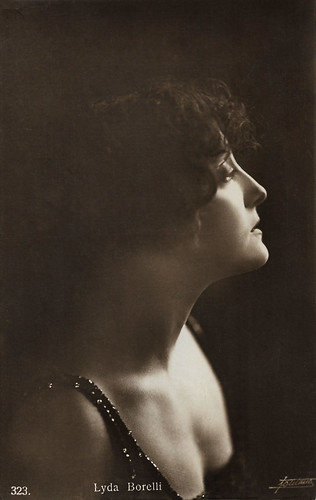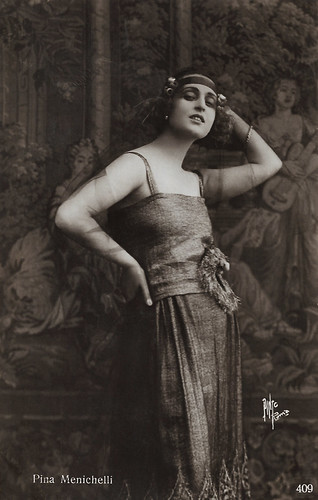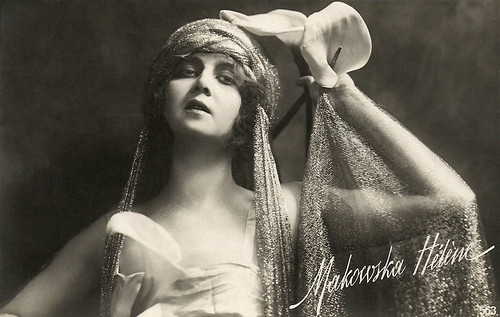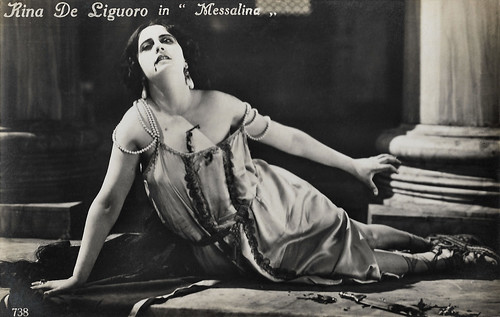Some of our most beautiful Italian postcards were published by Ed. A. Traldi. Traldi operated in Milan from 1902 on. The publisher concentrated on view cards of Europe and the Middle East. They are also known for a series published that focused on dogs. But we are most interested in the postcard portraits of European stage and film performers, and the cards with stills of silent films of the 1920s, often distributed by Pittaluga Films. After World War II, Ed. A. Traldi returned as Vetta Traldi with pin-up postcards and with the Divi del Cinema series.
![Elena Sangro in Maciste imperatore]()
Italian postcard by Ed. A. Traldi, Milano, no. 9. Photo: Pittaluga. Publicity still of Elena Sangro as Cinzia and René [Raoul] Mayllard as prince Otis [Ortis] in the Fert production Maciste imperatore/Emperor Maciste (Guido Brignone, 1924).
Maciste imperatore (1924) was part of the popular Maciste series of films starring Bartolomeo Pagano as the strongman Maciste. In the kingdom of Sindagna, the prince regent Stanos tries with all means to dispose of the legitime heir to the throne, prince Ortis. When Maciste and his companion Saetta happen to be in the chaotic empire, they set things straight for the poor, weak prince. Maciste is proclaimed emperor of Sindagna after getting rid of the regent and his puppet ruler, restores peace, and arranges that the prince can also be united with his beloved one. The plot line comes close Mussolini's take over of Italy, 'helping' the weak king Victor Emmanuel III and 'restoring order'.
![Lyda Borelli]()
Italian postcard by Ed. A. Traldi, Milano, no. 323. Photo: Fontana.
Considering her profile, it is not hard to imagine why critics and artists of the early 20th century compared stage and film diva Lyda Borelli (1887-1959) to the heroines of Aubrey Beardsley.
![Pina Menichelli]()
Italian postcard by Ed. A. Traldi, Milano, no. 409. Photo: Pinto, Roma.
Pina Menichelli(1890-1984) was one of the Italian divas of the silent era. After starting her film career at the Roman Cines company in 1913, she was catapulted into stardom by Giovanni Pastrone's Dannunzian film Il Fuoco (1915). Because of her femme fatale, men devouring type and her extreme and sudden gestures she was nicknamed Notre Dame des Spasmes. Menichelli did however know how to play also in restrained ways, as her masterpiece Tigre Reale (Pastrone 1916) showed.
![Helena Makowska]()
Italian postcard by Ed. A. Traldi, Milano, no. 563.
Polish singer and actress Helena Makowska aka Elena Makowska (1893-1964) was a beautiful diva of the Italian silent cinema in the 1910s. During the 1920s, she moved to Berlin and also became a star of the German cinema.
![Rina De Liguoro in Messalina]()
Italian postcard by Ed. A. Traldi, Milano, no. 738. Photo: publicity still of Rina De Liguoro dying in the final scene of Messalina (Enrico Guazzoni, 1924).
For diva Rina De Liguoro, the epic Messalina (1924) was the start of a prolific career in Italian silent cinema in the 1920s, with films like Quo vadis? (1924) and Gli ultimi giorni di Pompeii (1926). In the late 1920s she also performed in Germany and France, e.g. in Casanova (1927).
![Diomira Jacobini]()
Italian postcard by Ed. Traldi, Milano, no. 795. Photo: Pittaluga Films, Torino.
Diomira Jacobini (1899-1959) was one of the stars of the Italian silent cinema. She was the younger sister of diva Maria Jacobini, in whose shadow she always stayed. Diomira appeared in some 55 films in Italy, Germany and Denmark.
![Emilio Ghione in La cavalcata ardente]()
Italian postcard by Ed. A. Traldi, Milano. Photo: Westi SAIC. Publicity still for La cavalcata ardente (Carmine Gallone, 1925) with Emilio Ghione as the Prince of Santafé.
The highly successful film La cavalcata ardente (1925) was a melodrama set against the background of the conquest of Naples by Garibaldi's volunteers. Soava Gallone plays an aristocratic forced into marriage with an old prince (Emilio Ghione) but secretly in love with a patriot (Gabriel de Gravone).
![Franz Sala in Maciste all'inferno]()
Italian postcard by Ed. A. Traldi, Milano. Photo: Soc. A. Stefano Pittaluga, Torino. Publicity still for Maciste all'inferno/Maciste in Hell (Guido Brignone, 1926), with Franz Sala as the devil Barbariccia.
Franz Sala aka Francesco Sala (1886-1952) was a prolific actor of the Italian silent cinema, mostly playing the evil antagonist.
![Maciste all'inferno]()
Italian postcard by Ed. A. Traldi, Milano. Photo: Pittaluga Films, Torino. Publicity still for Maciste all'inferno (Guido Brignone, 1926), starring Bartolomeo Pagano as Maciste. Caption: "The Inhabitants of the Underworld."
![Maciste nella gabbia dei leoni (1926)]()
Italian postcard by Ed. A. Traldi, Milano, no. 819. Photo: Pittaluga Films, Torino. Publicity still for Maciste nella gabbia dei leoni/Maciste in the Lions' Cage (Guido Brignone, 1926).
Maciste nella gabbia dei leoni is an Italian silent adventure film directed by Guido Brignone for the Cinès-Pittaluga studio. In the script, written by Brignone, Maciste is sent to Africa by a circus showman to capture some lions. Maciste nella gabbia dei leoni was the penultimate film of the silent series, followed by Il gigante delle Dolomiti/The Giant of the Dolomites (Guido Brignone, 1927).
![Lucia Bosé]()
Italian postcard in the series Divi del Cinema by Vetta Traldi, Milano, no. 7.
Lucia Bosé (1931) is an Italian actress, known for her films from the 1950s for directors Giuseppe De Santis and Michelangelo Antonioni.
![Venetia Stevenson]()
Italian postcard in the series Divi del Cinema, no. 33, by Vetta Traldi, Milano.
Sultry, glamorous blonde Venetia Stevenson (1938) was a British-born Hollywood starlet of the late 1950s.
![Anna Maria Ferrero]()
Anna Maria Ferrero. Italian postcard by Vetta Traldi, Milano in the Divi del Cinema series, no. 51. Sent by mail in 1955.
![Anita Ekberg]()
Anita Ekberg. Italian postcard by Vetta Traldi, Milano in the Divi del Cinema series, no. 139 bis.
![Mamie Van Doren]()
Mamie Van Doren. Italian postcard in the series Divi del Cinema by Vetta Traldi, Milano, no 232.
Sources: The Cabinet Card Gallery and Wikipedia.

Italian postcard by Ed. A. Traldi, Milano, no. 9. Photo: Pittaluga. Publicity still of Elena Sangro as Cinzia and René [Raoul] Mayllard as prince Otis [Ortis] in the Fert production Maciste imperatore/Emperor Maciste (Guido Brignone, 1924).
Maciste imperatore (1924) was part of the popular Maciste series of films starring Bartolomeo Pagano as the strongman Maciste. In the kingdom of Sindagna, the prince regent Stanos tries with all means to dispose of the legitime heir to the throne, prince Ortis. When Maciste and his companion Saetta happen to be in the chaotic empire, they set things straight for the poor, weak prince. Maciste is proclaimed emperor of Sindagna after getting rid of the regent and his puppet ruler, restores peace, and arranges that the prince can also be united with his beloved one. The plot line comes close Mussolini's take over of Italy, 'helping' the weak king Victor Emmanuel III and 'restoring order'.

Italian postcard by Ed. A. Traldi, Milano, no. 323. Photo: Fontana.
Considering her profile, it is not hard to imagine why critics and artists of the early 20th century compared stage and film diva Lyda Borelli (1887-1959) to the heroines of Aubrey Beardsley.

Italian postcard by Ed. A. Traldi, Milano, no. 409. Photo: Pinto, Roma.
Pina Menichelli(1890-1984) was one of the Italian divas of the silent era. After starting her film career at the Roman Cines company in 1913, she was catapulted into stardom by Giovanni Pastrone's Dannunzian film Il Fuoco (1915). Because of her femme fatale, men devouring type and her extreme and sudden gestures she was nicknamed Notre Dame des Spasmes. Menichelli did however know how to play also in restrained ways, as her masterpiece Tigre Reale (Pastrone 1916) showed.

Italian postcard by Ed. A. Traldi, Milano, no. 563.
Polish singer and actress Helena Makowska aka Elena Makowska (1893-1964) was a beautiful diva of the Italian silent cinema in the 1910s. During the 1920s, she moved to Berlin and also became a star of the German cinema.

Italian postcard by Ed. A. Traldi, Milano, no. 738. Photo: publicity still of Rina De Liguoro dying in the final scene of Messalina (Enrico Guazzoni, 1924).
For diva Rina De Liguoro, the epic Messalina (1924) was the start of a prolific career in Italian silent cinema in the 1920s, with films like Quo vadis? (1924) and Gli ultimi giorni di Pompeii (1926). In the late 1920s she also performed in Germany and France, e.g. in Casanova (1927).

Italian postcard by Ed. Traldi, Milano, no. 795. Photo: Pittaluga Films, Torino.
Diomira Jacobini (1899-1959) was one of the stars of the Italian silent cinema. She was the younger sister of diva Maria Jacobini, in whose shadow she always stayed. Diomira appeared in some 55 films in Italy, Germany and Denmark.

Italian postcard by Ed. A. Traldi, Milano. Photo: Westi SAIC. Publicity still for La cavalcata ardente (Carmine Gallone, 1925) with Emilio Ghione as the Prince of Santafé.
The highly successful film La cavalcata ardente (1925) was a melodrama set against the background of the conquest of Naples by Garibaldi's volunteers. Soava Gallone plays an aristocratic forced into marriage with an old prince (Emilio Ghione) but secretly in love with a patriot (Gabriel de Gravone).

Italian postcard by Ed. A. Traldi, Milano. Photo: Soc. A. Stefano Pittaluga, Torino. Publicity still for Maciste all'inferno/Maciste in Hell (Guido Brignone, 1926), with Franz Sala as the devil Barbariccia.
Franz Sala aka Francesco Sala (1886-1952) was a prolific actor of the Italian silent cinema, mostly playing the evil antagonist.

Italian postcard by Ed. A. Traldi, Milano. Photo: Pittaluga Films, Torino. Publicity still for Maciste all'inferno (Guido Brignone, 1926), starring Bartolomeo Pagano as Maciste. Caption: "The Inhabitants of the Underworld."

Italian postcard by Ed. A. Traldi, Milano, no. 819. Photo: Pittaluga Films, Torino. Publicity still for Maciste nella gabbia dei leoni/Maciste in the Lions' Cage (Guido Brignone, 1926).
Maciste nella gabbia dei leoni is an Italian silent adventure film directed by Guido Brignone for the Cinès-Pittaluga studio. In the script, written by Brignone, Maciste is sent to Africa by a circus showman to capture some lions. Maciste nella gabbia dei leoni was the penultimate film of the silent series, followed by Il gigante delle Dolomiti/The Giant of the Dolomites (Guido Brignone, 1927).

Italian postcard in the series Divi del Cinema by Vetta Traldi, Milano, no. 7.
Lucia Bosé (1931) is an Italian actress, known for her films from the 1950s for directors Giuseppe De Santis and Michelangelo Antonioni.

Italian postcard in the series Divi del Cinema, no. 33, by Vetta Traldi, Milano.
Sultry, glamorous blonde Venetia Stevenson (1938) was a British-born Hollywood starlet of the late 1950s.

Anna Maria Ferrero. Italian postcard by Vetta Traldi, Milano in the Divi del Cinema series, no. 51. Sent by mail in 1955.

Anita Ekberg. Italian postcard by Vetta Traldi, Milano in the Divi del Cinema series, no. 139 bis.

Mamie Van Doren. Italian postcard in the series Divi del Cinema by Vetta Traldi, Milano, no 232.
Sources: The Cabinet Card Gallery and Wikipedia.